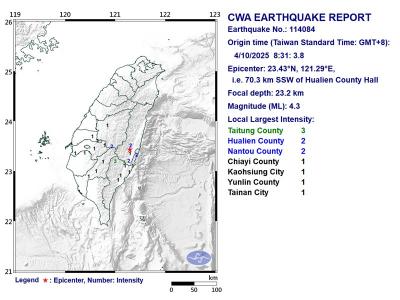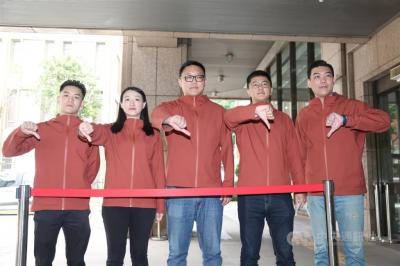Pingtung County nonagenarian Yang Tien-fu (楊天富), a Japanese merchant marine veteran, is one of the last living witnesses to the sinking of the Japanese landing craft transport ship Tamatsu Maru during World War II.
The Tamatsu Maru was torpedoed and sank with the loss of 5,000 lives off the coast of the Philippines near Luzon on Aug. 19, 1944.
Historian Nien Chih-cheng (念吉成) said Yang’s story will be included in his latest book about the Pacific War, which has the tentatively titled of Tears of Bashi Channel (巴士海峽之淚).

Photo: Tsai Tsung-hsien, Taipei Times
Yang, 91, recently talked about some of his wartime experiences with the Chinese-language Liberty Times (the Taipei Times’ sister newspaper).
After graduating from a public high school in Checheng Township (車城) at 16, Yang said he took the entrance exam for a merchant marine engineer’s course in Kobe, Japan, without telling his family.
Having passed the exam, he entered the program in April 1943, and after graduation, he was assigned to the cargo ship Osaka Maru, which ran supplies to a Japanese garrison on Saipan Island.
“That was how I got into the Pacific War,” he said.
The Osaka Maru was torpedoed by Allied submarines on May 25, 1944; Yang made it onto a lifeboat with an experienced sailor, Masayuki Tanaka, and six Japanese servicemen.
Although the lifeboat had ample potable water and rations, the six servicemen succumbed to psychological distress and depression, and only Yang and Tanaka survived.
After being rescued, Yang and Tanaka were transported to Samal Island, where he was drafted into a “temporary enlistment” to help with Japanese defenses, he said.
After the island was blockaded by an Allied fleet, most of the food ran out, and the Japanese troops subsisted mainly on stockpiled soybeans and they had to evade Filipino guerrillas, he said.
His knowledge of how to cook green mangoes, green bananas and cassava helped him and many of his comrades survive until they were able to be evacuated to Japan, he said.
He was then assigned as an engineer to the Kibitsu Maru, a merchant ship that had been converted into a military transport bristling with anti-aircraft batteries.
The Kibtitsu Maru left the port of Moji in Kyushu in August 1944 and joined the Tamatsu Maru and other ships in a convoy carrying units of the elite Kwantung Army to the Philippines, he said.
After the flotilla reached the Bashi Channel, Allied submarines torpedoed the Tamatsu Maru and sank it, he said.
“The surface of the sea was covered with the corpses of my comrades. I saw Japanese soldiers holding their rifles shouting ‘Long live the emperor’ as they drowned. Korean soldiers shouted ‘eomeoni,’ their word for ‘mother.’ It was a terrible sight that I cannot forget,” he said.
The Kibitsu Maru was evacuating 500 sick or injured women of “special status” from Manila when it came under incessant air attacks on Aug. 7, 1945, that forced it to flee the Bashi Channel to Siaoliouciou Island (小琉球) off Pingtung.
The attacks were so intense that he was ordered to replace a wounded machine-gun loader and a blast blew his helmet off, he said.
“I took a cooking pot made of copper from the kitchen and put it on my head as a helmet. It was a dangerous battle,” he said.
Years later he ran into Hidetsugu Nakajima, a survivor of the Tamasui Maru, in Pingtung’s Hengchun Township (恆春), he said.
“We shared a very sad history,” he said.

Taiwan is stepping up plans to create self-sufficient supply chains for combat drones and increase foreign orders from the US to counter China’s numerical superiority, a defense official said on Saturday. Commenting on condition of anonymity, the official said the nation’s armed forces are in agreement with US Admiral Samuel Paparo’s assessment that Taiwan’s military must be prepared to turn the nation’s waters into a “hellscape” for the Chinese People’s Liberation Army (PLA). Paparo, the commander of the US Indo-Pacific Command, reiterated the concept during a Congressional hearing in Washington on Wednesday. He first coined the term in a security conference last

A magnitude 4.3 earthquake struck eastern Taiwan's Hualien County at 8:31am today, according to the Central Weather Administration (CWA). The epicenter of the temblor was located in Hualien County, about 70.3 kilometers south southwest of Hualien County Hall, at a depth of 23.2km, according to the administration. There were no immediate reports of damage resulting from the quake. The earthquake's intensity, which gauges the actual effect of a temblor, was highest in Taitung County, where it measured 3 on Taiwan's 7-tier intensity scale. The quake also measured an intensity of 2 in Hualien and Nantou counties, the CWA said.

The Overseas Community Affairs Council (OCAC) yesterday announced a fundraising campaign to support survivors of the magnitude 7.7 earthquake that struck Myanmar on March 28, with two prayer events scheduled in Taipei and Taichung later this week. “While initial rescue operations have concluded [in Myanmar], many survivors are now facing increasingly difficult living conditions,” OCAC Minister Hsu Chia-ching (徐佳青) told a news conference in Taipei. The fundraising campaign, which runs through May 31, is focused on supporting the reconstruction of damaged overseas compatriot schools, assisting students from Myanmar in Taiwan, and providing essential items, such as drinking water, food and medical supplies,

Prosecutors today declined to say who was questioned regarding alleged forgery on petitions to recall Democratic Progressive Party (DPP) legislators, after Chinese-language media earlier reported that members of the Chinese Nationalist Party (KMT) Youth League were brought in for questioning. The Ministry of Justice Investigation Bureau confirmed that two people had been questioned, but did not disclose any further information about the ongoing investigation. KMT Youth League members Lee Hsiao-liang (李孝亮) and Liu Szu-yin (劉思吟) — who are leading the effort to recall DPP caucus chief executive Rosalia Wu (吳思瑤) and Legislator Wu Pei-yi (吳沛憶) — both posted on Facebook saying: “I